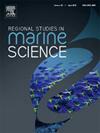Using end-member model algorithm to infer sedimentary processes from mangrove sediment grain-size in Guangdong, South China
IF 2.1
4区 环境科学与生态学
Q3 ECOLOGY
引用次数: 0
Abstract
Mangrove wetlands, situated between terrestrial and marine environments, are highly sensitive to environmental changes. This study investigates the grain-size characteristics of mangrove sediments in four wetlands along Guangdong's coast, South China, to infer deposition processes and environmental changes. Using the Basic End-Member Model Algorithm (BasEMMA), we identified four sediment end-members (EMs): fluvial clay (EM1), tidal current suspending load (EM2), fluvial silt (EM3), and storm surge deposit (EM4) for Guangdong mangrove wetlands, with distinct modal sizes ranging from 1.78 φ to 8.58 φ. Mangrove sediment grain-size is mainly influenced by sediment sources, with tidal inputs (EM2) predominating. EMs compositions display significant differences in estuarine mangroves in different regions of Guangdong, but not in bay mangroves. In addition to sediment sources, anthropogenic disturbances and management practices, including logging, mangrove planting and construction, also affect mangrove sediment grain-size, and planted mangroves exhibit larger particle sizes compared to natural counterparts within the same region. After the introduction of mangroves into estuaries, the wetland sedimentary environment became stable, and the sediments have more significant changes than those in bays. The study demonstrates the utility of EMMA in precisely distinguishing mangrove sediment components, offering insights into sediment source dynamics and environmental changes throughout mangrove ecosystem development.
求助全文
约1分钟内获得全文
求助全文
来源期刊

Regional Studies in Marine Science
Agricultural and Biological Sciences-Ecology, Evolution, Behavior and Systematics
CiteScore
3.90
自引率
4.80%
发文量
336
审稿时长
69 days
期刊介绍:
REGIONAL STUDIES IN MARINE SCIENCE will publish scientifically sound papers on regional aspects of maritime and marine resources in estuaries, coastal zones, continental shelf, the seas and oceans.
 求助内容:
求助内容: 应助结果提醒方式:
应助结果提醒方式:


